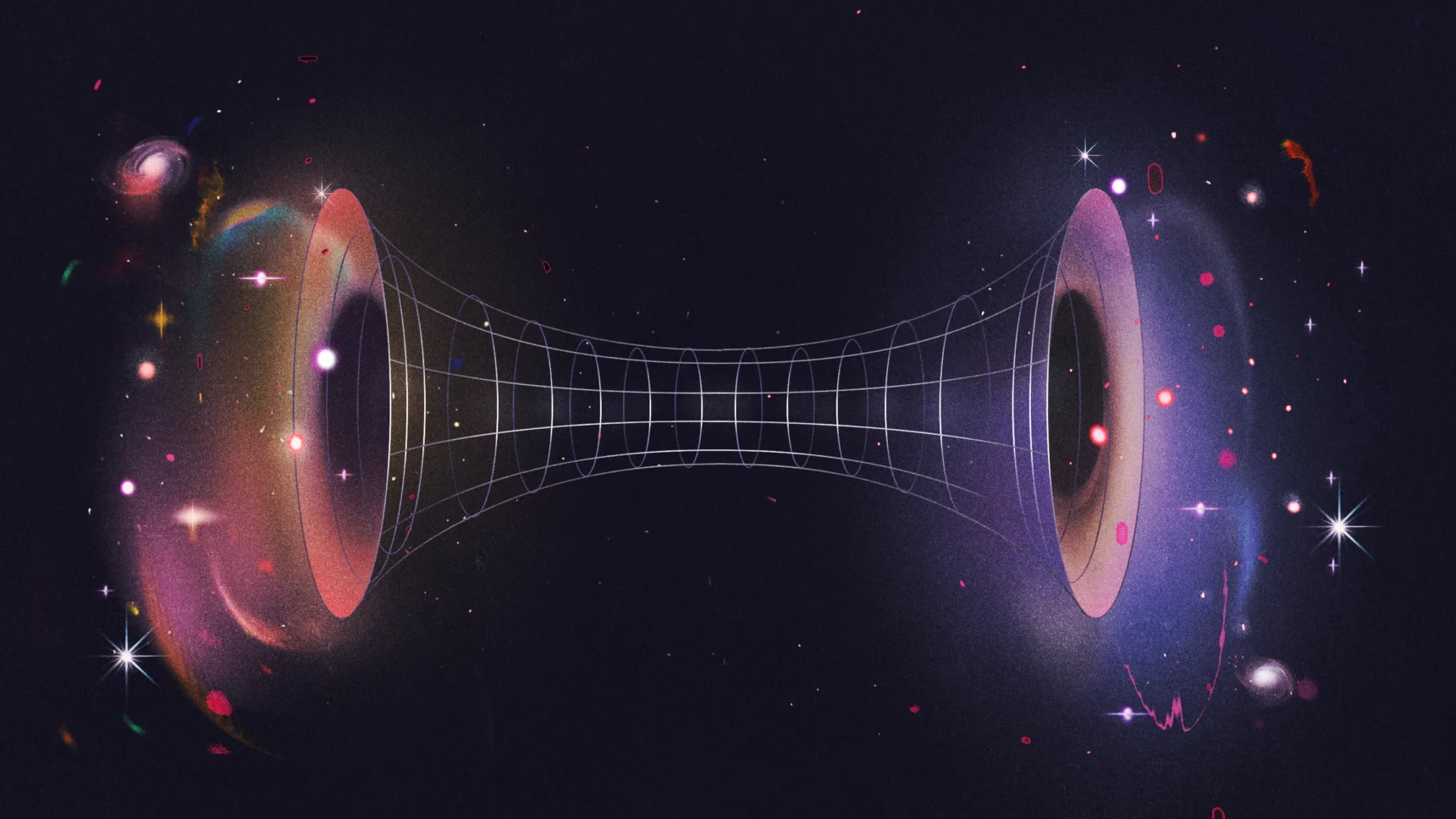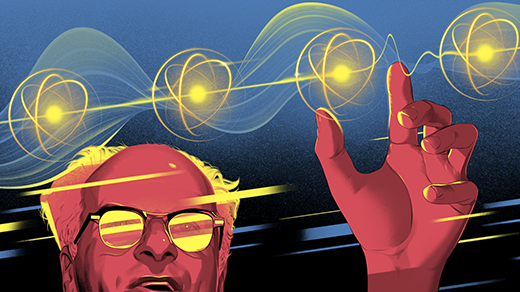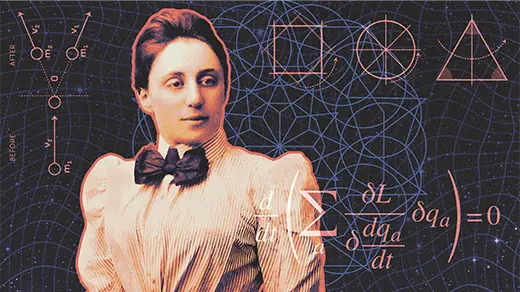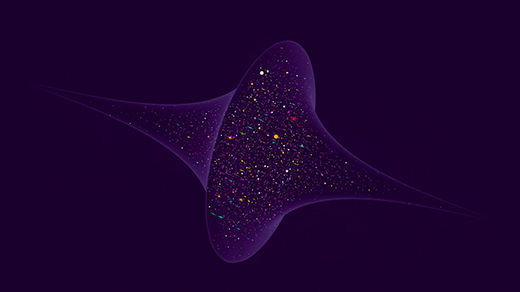Physicists Create a Holographic Wormhole Using a Quantum Computer
Introduction
Editor’s note: In February 2023, a team of physicists led by Norman Yao of Harvard University published a comment about the holographic wormhole experiment described in this article. After analyzing the mathematical properties of the model used to simulate the wormhole in a quantum computer, the group concluded that the teleportation demonstration should not be thought of as a holographic wormhole. They argue that the model underlying the experiment was too simple to capture key properties of gravitational systems such as black holes and wormholes. The comment has not yet been peer reviewed, but independent experts contacted by Quanta find the arguments compelling. Our ongoing coverage is available here: https://www.quantamagazine.org/wormhole-experiment-called-into-question-20230323/
Physicists have purportedly created the first-ever wormhole, a kind of tunnel theorized in 1935 by Albert Einstein and Nathan Rosen that leads from one place to another by passing into an extra dimension of space.
The wormhole emerged like a hologram out of quantum bits of information, or “qubits,” stored in tiny superconducting circuits. By manipulating the qubits, the physicists then sent information through the wormhole, they reported today in the journal Nature.
The team, led by Maria Spiropulu of the California Institute of Technology, implemented the novel “wormhole teleportation protocol” using Google’s quantum computer, a device called Sycamore housed at Google Quantum AI in Santa Barbara, California. With this first-of-its-kind “quantum gravity experiment on a chip,” as Spiropulu described it, she and her team beat a competing group of physicists who aim to do wormhole teleportation with IBM and Quantinuum’s quantum computers.
When Spiropulu saw the key signature indicating that qubits were passing through the wormhole, she said, “I was shaken.”
The experiment can be seen as evidence for the holographic principle, a sweeping hypothesis about how the two pillars of fundamental physics, quantum mechanics and general relativity, fit together. Physicists have strived since the 1930s to reconcile these disjointed theories — one, a rulebook for atoms and subatomic particles, the other, Einstein’s description of how matter and energy warp the space-time fabric, generating gravity. The holographic principle, ascendant since the 1990s, posits a mathematical equivalence or “duality” between the two frameworks. It says the bendy space-time continuum described by general relativity is really a quantum system of particles in disguise. Space-time and gravity emerge from quantum effects much as a 3D hologram projects out of a 2D pattern.
Indeed, the new experiment confirms that quantum effects, of the type that we can control in a quantum computer, can give rise to a phenomenon that we expect to see in relativity — a wormhole. The evolving system of qubits in the Sycamore chip “has this really cool alternative description,” said John Preskill, a theoretical physicist at Caltech who was not involved in the experiment. “You can think of the system in a very different language as being gravitational.”
To be clear, unlike an ordinary hologram, the wormhole isn’t something we can see. While it can be considered “a filament of real space-time,” according to co-author Daniel Jafferis of Harvard University, lead developer of the wormhole teleportation protocol, it’s not part of the same reality that we and the Sycamore computer inhabit. The holographic principle says that the two realities — the one with the wormhole and the one with the qubits — are alternate versions of the same physics, but how to conceptualize this kind of duality remains mysterious.
Opinions will differ about the fundamental implications of the result. Crucially, the holographic wormhole in the experiment consists of a different kind of space-time than the space-time of our own universe. It’s debatable whether the experiment furthers the hypothesis that the space-time we inhabit is also holographic, patterned by quantum bits.
“I think it is true that gravity in our universe is emergent from some quantum [bits] in the same way that this little baby one-dimensional wormhole is emergent” from the Sycamore chip, Jafferis said. “Of course we don’t know that for sure. We’re trying to understand it.”
Into the Wormhole
The story of the holographic wormhole traces back to two seemingly unrelated papers published in 1935: one by Einstein and Rosen, known as ER, the other by the two of them and Boris Podolsky, known as EPR. Both the ER and EPR papers were initially judged as marginal works of the great E. That has changed.
In the ER paper, Einstein and his young assistant, Rosen, stumbled upon the possibility of wormholes while attempting to extend general relativity into a unified theory of everything — a description not only of space-time, but of the subatomic particles suspended in it. They had homed in on snags in the space-time fabric that the German physicist-soldier Karl Schwarzschild had found among the folds of general relativity in 1916, mere months after Einstein published the theory. Schwarzschild showed that mass can gravitationally attract itself so much that it becomes infinitely concentrated at a point, curving space-time so sharply there that variables turn infinite and Einstein’s equations malfunction. We now know that these “singularities” exist throughout the universe. They are points we can neither describe nor see, each one hidden at the center of a black hole that gravitationally traps all nearby light. Singularities are where a quantum theory of gravity is most needed.
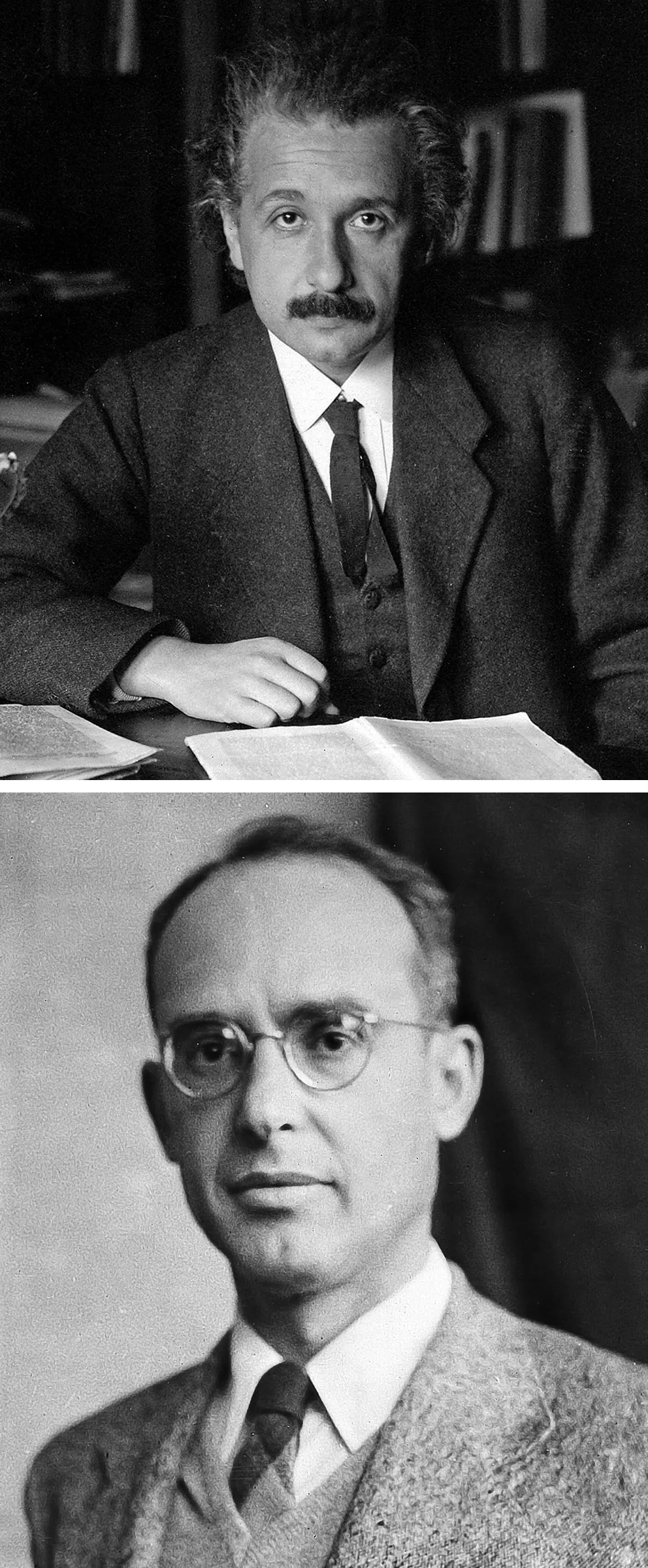
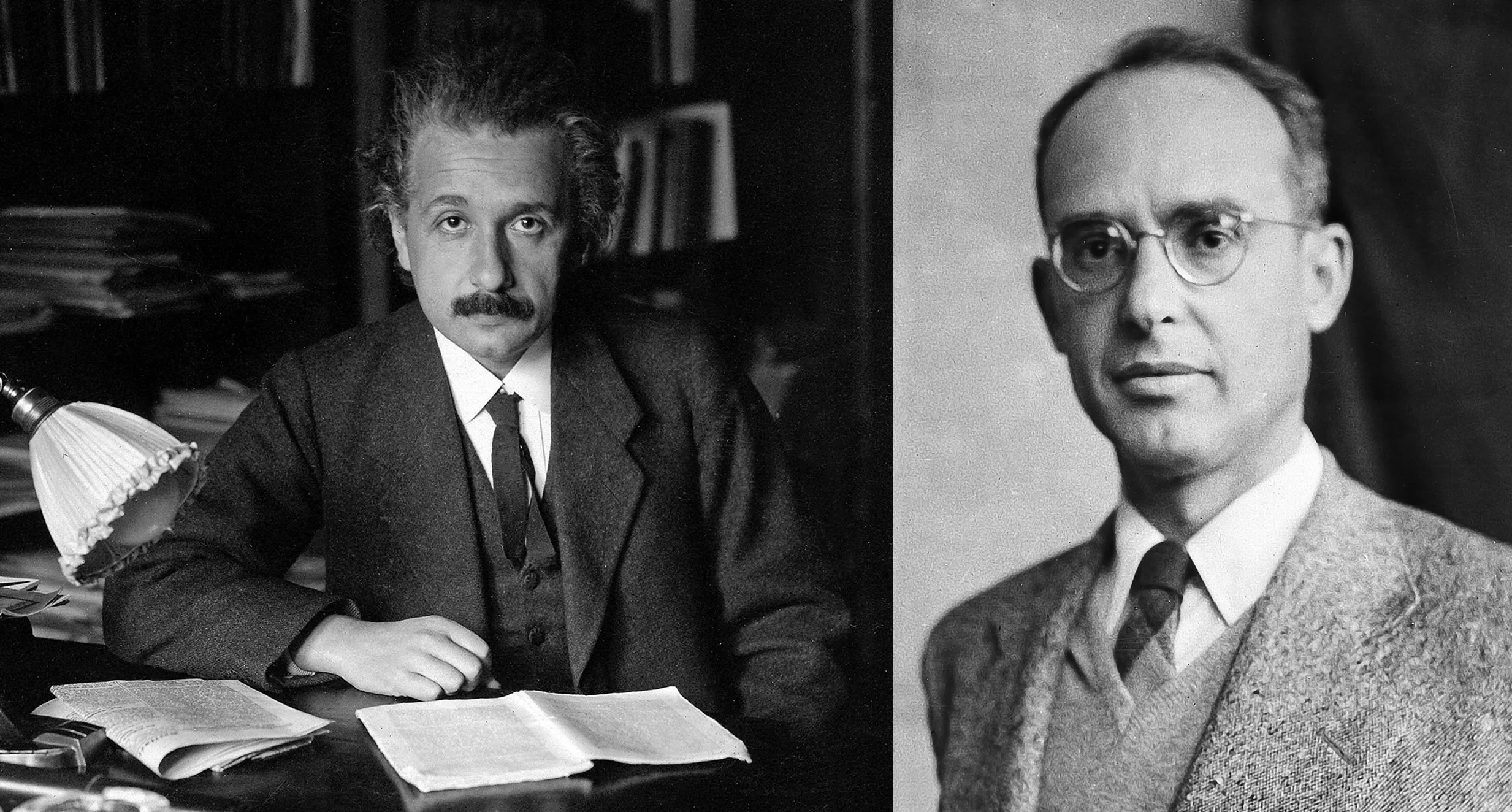
Albert Einstein, pictured on the top in 1920, and Nathan Rosen, pictured around 1955, stumbled across the possibility of wormholes in a 1935 paper.
The Scientific Monthly (top); AIP Emilio Segrè Visual Archives, Physics Today Collection
Albert Einstein, pictured on the left in 1920, and Nathan Rosen, pictured around 1955, stumbled across the possibility of wormholes in a 1935 paper.
The Scientific Monthly (left); AIP Emilio Segrè Visual Archives, Physics Today Collection
Einstein and Rosen speculated that Schwarzschild’s math might be a way to plug elementary particles into general relativity. To make the picture work, they snipped the singularity out of his equations, swapping in new variables that replaced the sharp point with an extra-dimensional tube sliding to another part of space-time. Einstein and Rosen argued, wrongly but presciently, that these “bridges” (or wormholes) might represent particles.
Ironically, in striving to link wormholes and particles, the duo did not consider the strange particle phenomenon they had identified two months earlier with Podolsky, in the EPR paper: quantum entanglement.
Entanglement arises when two particles interact. According to quantum rules, particles can have multiple possible states at once. This means an interaction between particles has multiple possible outcomes, depending on which state each particle is in to begin with. Always, though, their resulting states will be linked — how particle A ends up depends on how particle B turns out. After such an interaction, the particles have a shared formula that specifies the various combined states they might be in.
The shocking consequence, which caused the EPR authors to doubt quantum theory, is “spooky action at a distance,” as Einstein put it: Measuring particle A (which picks out one reality from among its possibilities) instantly decides the corresponding state of B, no matter how far away B is.
Entanglement has shot up in perceived importance since physicists discovered in the 1990s that it allows new kinds of computations. Entangling two qubits — quantum objects like particles that exist in two possible states, 0 and 1 — yields four possible states with different likelihoods (0 and 0, 0 and 1, 1 and 0, and 1 and 1). Three qubits make eight simultaneous possibilities, and so on; the power of a “quantum computer” grows exponentially with each additional entangled qubit. Cleverly orchestrate the entanglement, and you can cancel out all combinations of 0s and 1s except the sequence that gives the answer to a calculation. Prototype quantum computers made of a few dozen qubits have materialized in the last couple of years, led by Google’s 54-qubit Sycamore machine.
Meanwhile, quantum gravity researchers have fixated on quantum entanglement for another reason: as the possible source code of the space-time hologram.
ER = EPR
Talk of emergent space-time and holography started in the late 1980s, after the black hole theorist John Wheeler promulgated the view that space-time and everything in it might spring from information. Soon, other researchers, including the Dutch physicist Gerard ’t Hooft, wondered whether this emergence might resemble the projection of a hologram. Examples had cropped up in black hole studies and in string theory, where one description of a physical scenario could be translated into an equally valid view of it with one extra spatial dimension. In a 1994 paper titled “The World as a Hologram,” Leonard Susskind, a quantum gravity theorist at Stanford University, fleshed out ’t Hooft’s holographic principle, arguing that a volume of bendy space-time described by general relativity is equivalent, or “dual,” to a system of quantum particles on the region’s lower-dimensional boundary.
A momentous example of holography arrived three years later. Juan Maldacena, a quantum gravity theorist now at the Institute for Advanced Study in Princeton, New Jersey, discovered that a kind of space called anti-de Sitter (AdS) space is, indeed, a hologram.
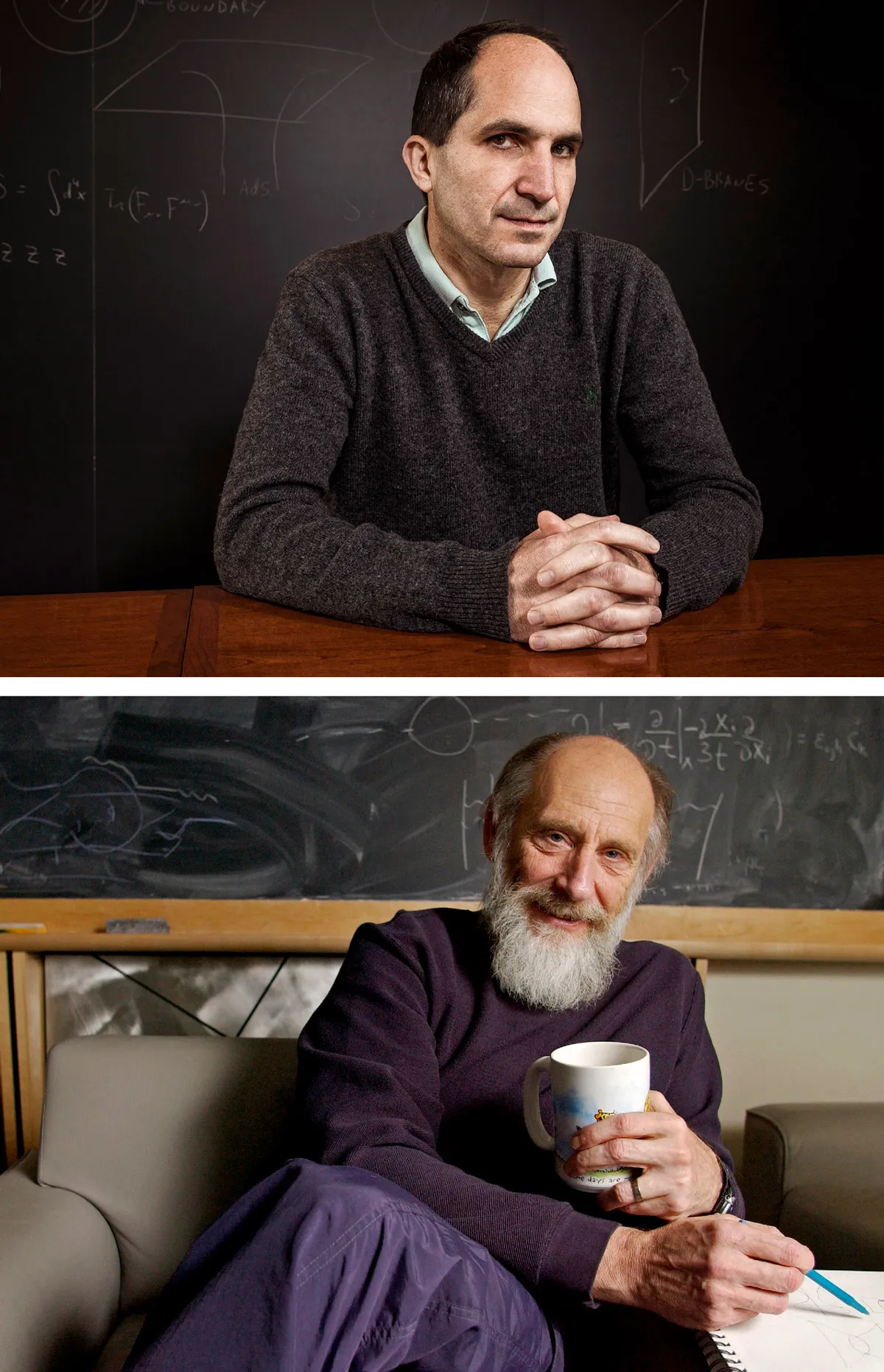
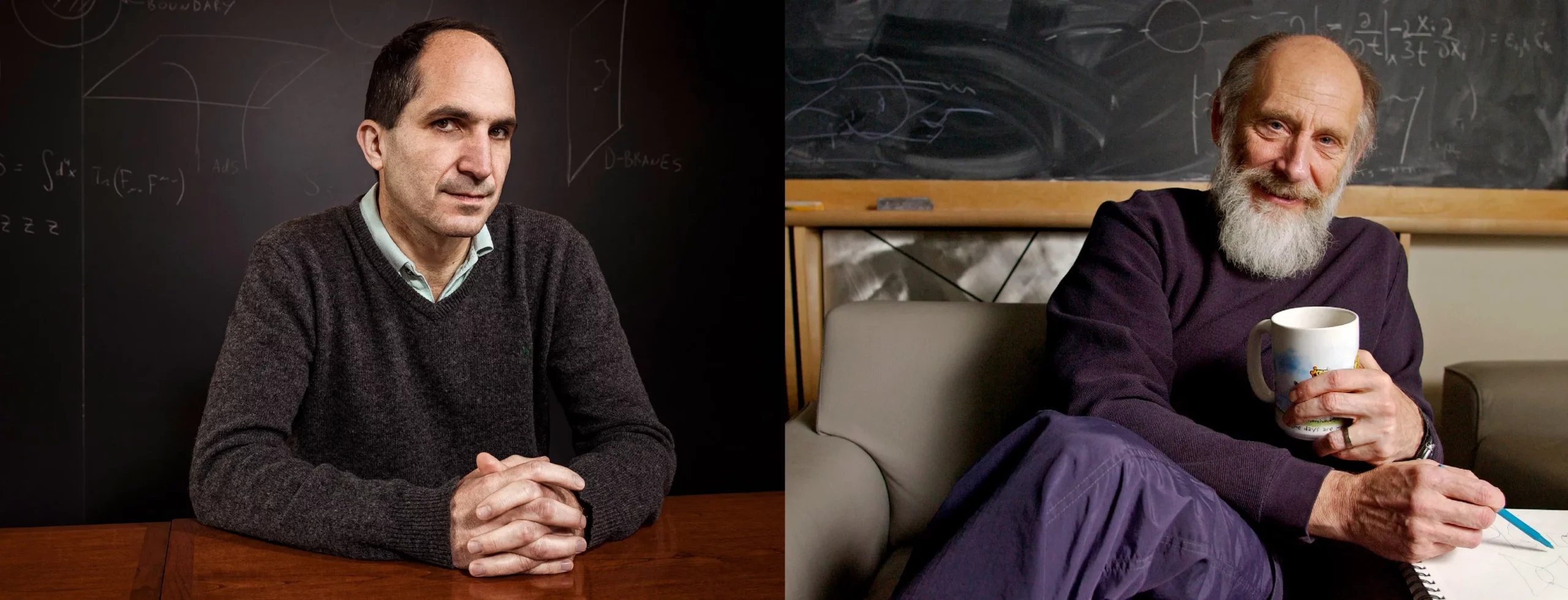
Juan Maldacena (top) and Leonard Susskind are leaders of the approach to quantum gravity known as holography. In 2013, they proposed that wormholes in space-time are equivalent to quantum entanglement, a conjecture known as ER = EPR.
Sasha Maslov for Quanta Magazine (top); Linda A. Cicero/Stanford News Service
Juan Maldacena (left) and Leonard Susskind are leaders of the approach to quantum gravity known as holography. In 2013, they proposed that wormholes in space-time are equivalent to quantum entanglement, a conjecture known as ER = EPR.
Sasha Maslov for Quanta Magazine (left); Linda A. Cicero/Stanford News Service
The actual universe is de Sitter space, an ever-growing sphere driven outward by its own positive energy. By contrast, AdS space is infused with negative energy — resulting from a difference in the sign of one constant in the equations of general relativity — giving the space a “hyperbolic” geometry: Objects shrink as they move outward from the center of the space, becoming infinitesimal at an outer boundary. Maldacena showed that space-time and gravity inside an AdS universe exactly correspond to properties of a quantum system on the boundary (specifically a system called a conformal field theory, or CFT).
Maldacena’s bombshell 1997 paper describing this “AdS/CFT correspondence” has been cited by subsequent studies 22,000 times — more than twice a day on average. “Trying to exploit ideas based on AdS/CFT has been the main goal of thousands of the best theorists for decades,” said Peter Woit, a mathematical physicist at Columbia University.
As Maldacena himself explored his AdS/CFT map between dynamical space-times and quantum systems, he made a new discovery about wormholes. He was studying a particular entanglement pattern involving two sets of particles, where each particle in one set is entangled with a particle in the other. Maldacena showed that this state is mathematically dual to a rather dramatic hologram: a pair of black holes in AdS space whose interiors connect via a wormhole.
A decade had to pass before Maldacena, in 2013 (under circumstances that “to be frank, I do not remember,” he says), realized that his discovery might signify a more general correspondence between quantum entanglement and connection via wormhole. He coined a cryptic little equation — ER = EPR — in an email to Susskind, who understood immediately. The two quickly developed the conjecture together, writing, “We argue that the Einstein Rosen bridge between two black holes is created by EPR-like correlations between the microstates of the two black holes,” and that the duality might be more general than that: “It is very tempting to think that any EPR correlated system is connected by some sort of ER bridge.”
Maybe a wormhole links every entangled pair of particles in the universe, forging a spatial connection that records their shared histories. Maybe Einstein’s hunch that wormholes have to do with particles was right.
A Sturdy Bridge
When Jafferis heard Maldacena lecture about ER = EPR at a conference in 2013, he realized that the conjectured duality should allow you to design bespoke wormholes by tailoring the entanglement pattern.
Standard Einstein-Rosen bridges are a disappointment to sci-fi fans everywhere: Were one to form, it would quickly collapse under its own gravity and pinch off long before a spaceship or anything else could get through. But Jafferis imagined stringing a wire or any other physical connection between the two sets of entangled particles that encode a wormhole’s two mouths. With this kind of coupling, operating on the particles on one side would induce changes to the particles on the other, perhaps propping open the wormhole between them. “Could it be that that makes the wormhole traversable?” Jafferis recalls wondering. Having been fascinated by wormholes since childhood — a physics prodigy, he started at Yale University at 14 — Jafferis pursued the question “almost for fun.”
Back at Harvard, he and Ping Gao, his graduate student at the time, and Aron Wall, then a visiting researcher, eventually calculated that, indeed, by coupling two sets of entangled particles, you can perform an operation on the left-hand set that, in the dual, higher-dimensional space-time picture, holds open the wormhole leading to the right-hand mouth and pushes a qubit through.
Jafferis, Gao and Wall’s 2016 discovery of this holographic, traversable wormhole gave researchers a new window into the mechanics of holography. “The fact that if you do the right things from the outside you can end up getting through, it also means you can see inside” the wormhole, Jafferis said. “It means that it’s possible to probe this fact that two entangled systems get described by some connected geometry.”
Within months, Maldacena and two colleagues had built on the scheme by showing that the traversable wormhole could be realized in a simple setting — “a quantum system that’s simple enough that we can imagine making it,” Jafferis said.
The SYK model, as it’s called, is a system of matter particles that interact in groups, rather than the usual pairs. First described by Subir Sachdev and Jinwu Ye in 1993, the model suddenly mattered much more starting in 2015 when the theoretical physicist Alexei Kitaev discovered that it is holographic. At a lecture that year in Santa Barbara, California, Kitaev (who became the K in SYK) filled several chalkboards with evidence that the particular version of the model in which matter particles interact in groups of four is mathematically mappable to a one-dimensional black hole in AdS space, with identical symmetries and other properties. “Some answers are the same in the two cases,” he told a rapt audience. Maldacena was sitting in the front row.
Merrill Sherman/Quanta Magazine
Connecting the dots, Maldacena and co-authors proposed that two SYK models linked together could encode the two mouths of Jafferis, Gao and Wall’s traversable wormhole. Jafferis and Gao ran with the approach. By 2019, they found their way to a concrete prescription for teleporting a qubit of information from one system of four-way-interacting particles to another. Rotating all the particles’ spin directions translates, in the dual space-time picture, into a negative-energy shock wave that sweeps through the wormhole, kicking the qubit forward and, at a predictable time, out of the mouth.
“Jafferis’ wormhole is the first concrete realization of ER = EPR, where he shows the relation holds exactly for a particular system,” said Alex Zlokapa, a graduate student at the Massachusetts Institute of Technology and a co-author on the new experiment.
Wormhole in the Lab
As the theoretical work was developing, Maria Spiropulu, an accomplished experimental particle physicist who was involved in the 2012 discovery of the Higgs boson, was thinking about how to use nascent quantum computers to do holographic quantum gravity experiments. In 2018 she persuaded Jafferis to join her growing team, along with researchers at Google Quantum AI — keepers of the Sycamore device.
To run Jafferis and Gao’s wormhole teleportation protocol on the state-of-the-art but still small and error-prone quantum computer, Spiropulu’s team had to greatly simplify the protocol. A full SYK model consists of practically infinitely many particles coupled to one another with random strengths as four-way interactions occur throughout. This is not feasible to calculate; even using all 50-odd available qubits would have required hundreds of thousands of circuit operations. The researchers set out to create a holographic wormhole with just seven qubits and hundreds of operations. To do this, they had to “sparsify” the seven-particle SYK model, encoding only the strongest four-way interactions and eliding the rest, while retaining the model’s holographic properties. “That took a couple of years to figure out a clever way to do it,” Spiropulu said.
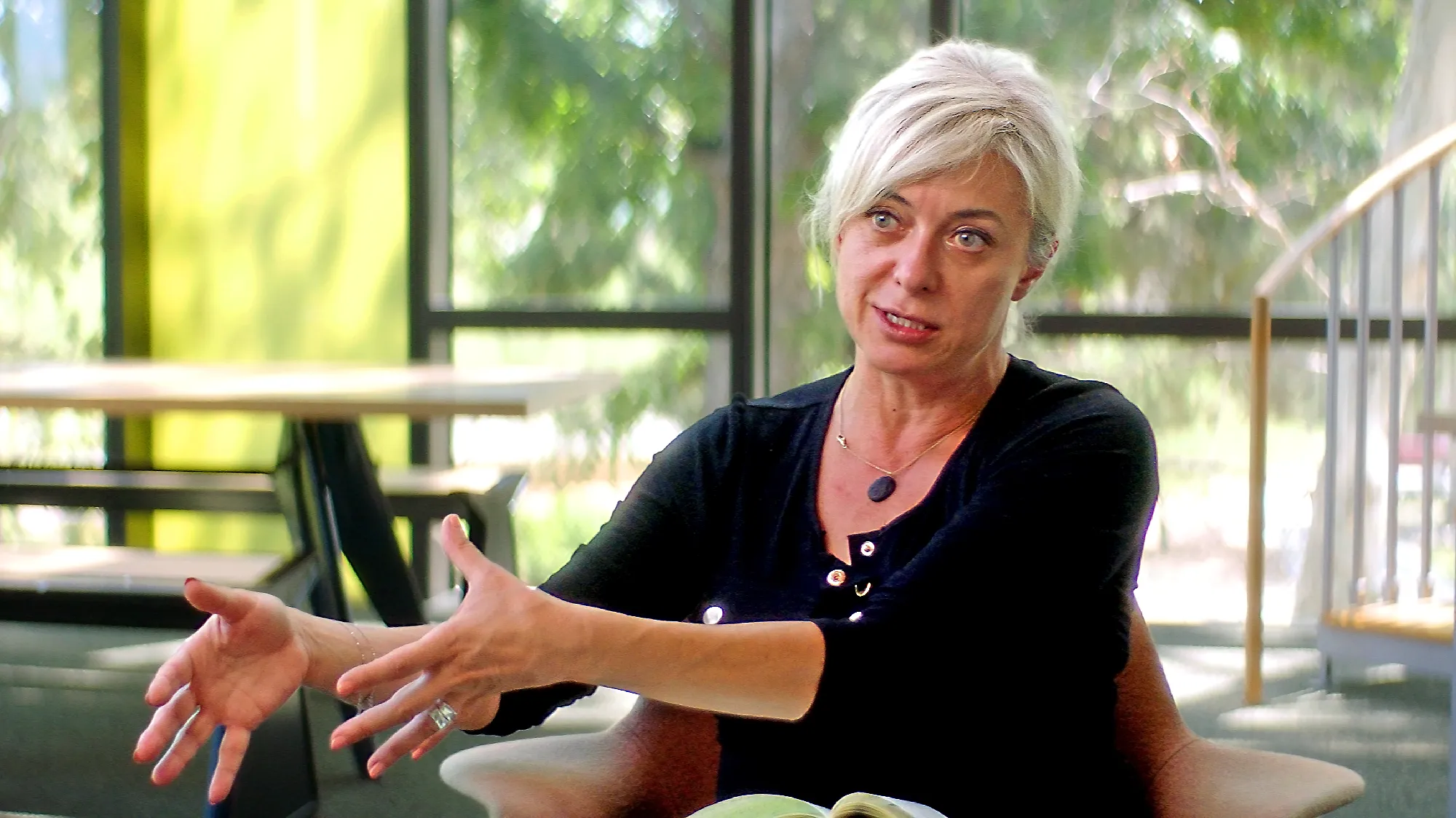
Maria Spiropulu, a physicist at the California Institute of Technology, led the team behind the new wormhole experiment.
Bongani Mlambo for Quanta Magazine
One secret to success was Zlokapa, a waifish orchestra kid who joined Spiropulu’s research group as a Caltech undergrad. A gifted programmer, Zlokapa mapped the particle interactions of the SYK model onto the connections between neurons of a neural network, and trained the system to delete as many network connections as possible while preserving a key wormhole signature. The procedure reduced the number of four-way interactions from hundreds down to five.
With that, the team started programming Sycamore’s qubits. Seven qubits encode 14 matter particles — seven each in the left and right SYK systems, where every particle on the left is entangled with one on the right. An eighth qubit, in some probabilistic combination of states 0 and 1, is then swapped with one of the particles from the left SYK model. That qubit’s possible states quickly get tangled up with the states of the other particles on the left, spreading its information evenly among them like a drop of ink in water. This is holographically dual to the qubit entering the left mouth of a one-dimensional wormhole in AdS space.
Then comes the big rotation of all the qubits, dual to a pulse of negative energy coursing through the wormhole. The rotation causes the injected qubit to transfer to the particles of the right-hand SYK model. Then the information un-spreads, Preskill said, “like chaos run backward,” and refocuses at the site of a single particle on the right — the entangled partner of the left-hand particle that was swapped out. Then the qubits’ states are all measured. Tallying 0s and 1s over many experimental runs and comparing these statistics to the prepared state of the injected qubits reveals whether qubits are teleporting over.
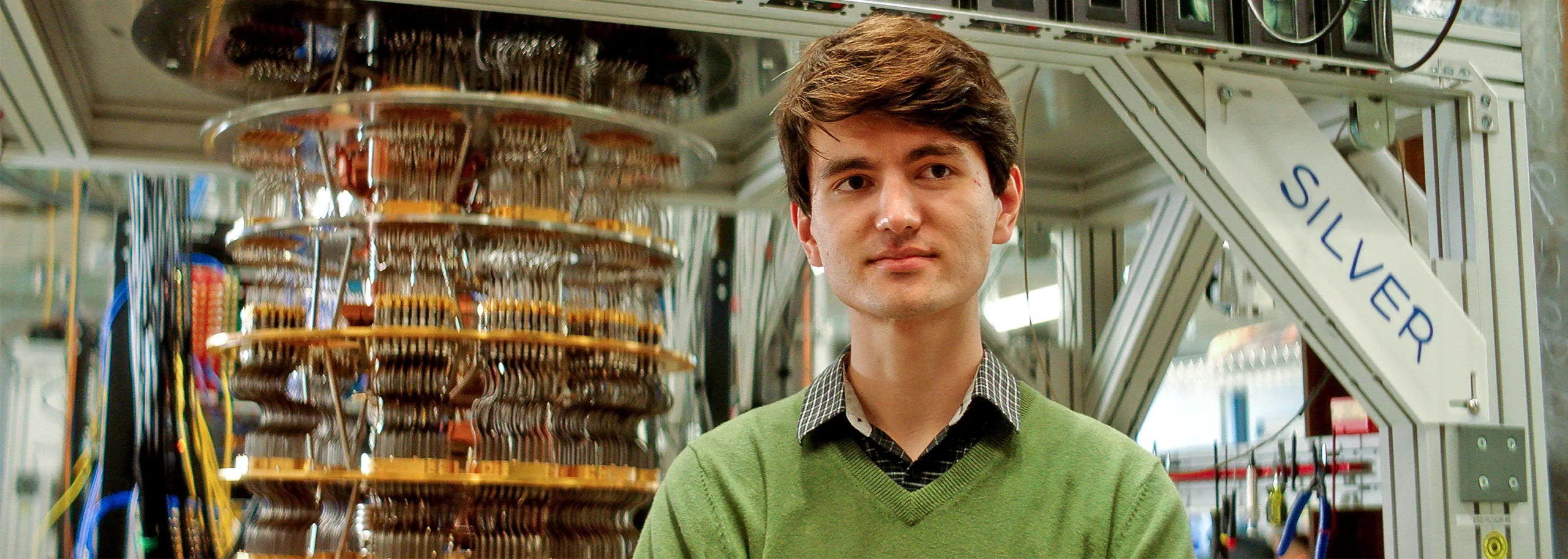
Alex Zlokapa, a graduate student at the Massachusetts Institute of Technology who joined the wormhole project as an undergrad, found a way to simplify the wormhole protocol enough to run it on Google’s quantum computer.
Bongani Mlambo for Quanta Magazine
The researchers look for a peak in the data that represents a difference between two cases: If they see the peak, it means qubit rotations that are dual to negative-energy pulses are allowing qubits to teleport, whereas rotations in the opposite direction, which are dual to pulses of normal, positive energy, don’t let qubits through. (Instead, they cause the wormhole to close.)
Late one night in January, after two years of gradual improvements and noise-reduction efforts, Zlokapa ran the finished protocol on Sycamore remotely from his childhood bedroom in the San Francisco Bay Area, where he was spending winter break after his first semester of grad school.
The peak appeared on his computer screen.
“It kept getting sharper and sharper,” he said. “I was sending screenshots of the peak to Maria and getting very excited, writing, ‘I think we see a wormhole now.’” The peak was “the first sign that you could see gravity on a quantum computer.”
Spiropulu says she could hardly believe the clean, pronounced peak she was seeing. “It was very similar to when I saw the first data for the Higgs discovery,” she said. “Not because I didn’t expect it, but it came too much in my face.”
Surprisingly, despite the skeletal simplicity of their wormhole, the researchers detected a second signature of wormhole dynamics, a delicate pattern in the way information spread and un-spread among the qubits known as “size-winding.” They hadn’t trained their neural network to preserve this signal as it sparsified the SYK model, so the fact that size-winding shows up anyway is an experimental discovery about holography.
“We didn’t demand anything about this size-winding property, but we found that it just popped out,” Jafferis said. This “confirmed the robustness” of the holographic duality, he said. “Make one [property] appear, then you get all the rest, which is a kind of evidence that this gravitational picture is the correct one.”
The Meaning of the Wormhole
Jafferis, who never expected to be part of a wormhole experiment (or any other), thinks one of the most important takeaways is what the experiment says about quantum mechanics. Quantum phenomena like entanglement are normally opaque and abstract; we don’t know, for instance, how a measurement of particle A determines B’s state from afar. But in the new experiment, an ineffable quantum phenomenon — information teleporting between particles — has a tangible interpretation as a particle receiving a kick of energy and moving at a calculable speed from A to B. “There seems to be this nice story from the point of view of the qubit; it moves causally,” said Jafferis. Maybe a quantum process like teleportation “always feels gravitational to that qubit. If something like that could come out of this experiment and other related experiments, that will definitely tell us something deep about our universe.”
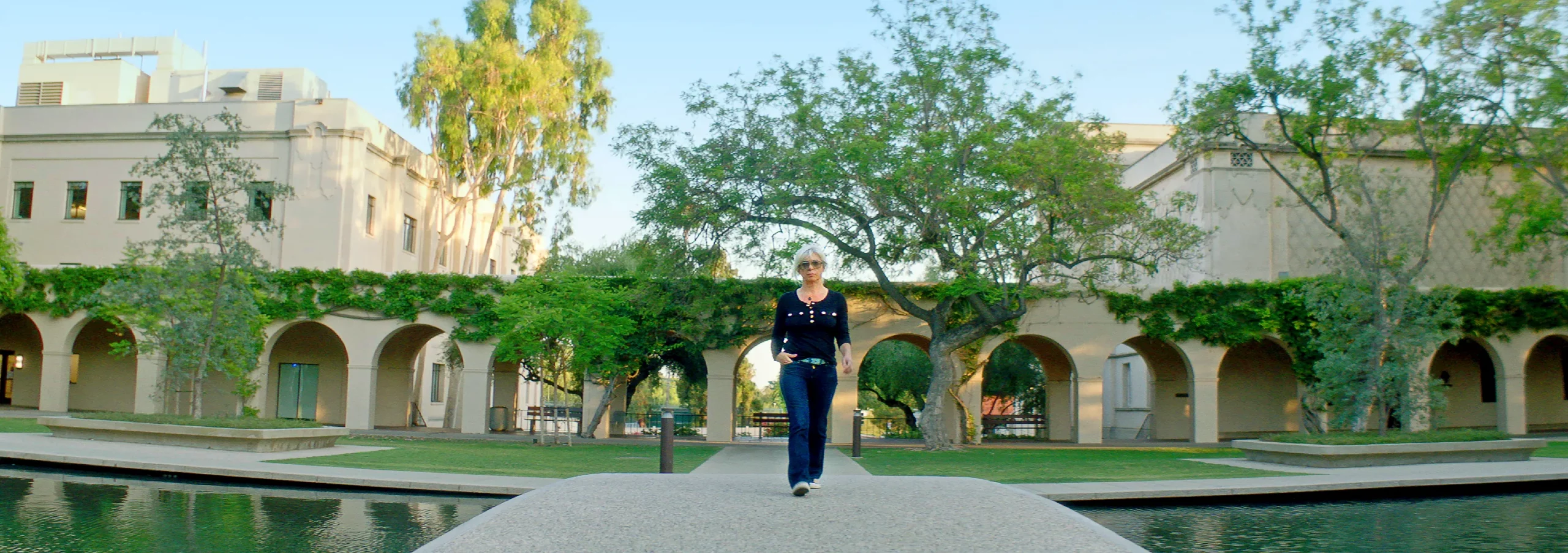
Maria Spiropulu on the campus of the California Institute of Technology.
Bongani Mlambo for Quanta Magazine
Susskind, who got an early look at today’s results, said he hopes that future wormhole experiments involving many more qubits can be used to explore the wormhole’s interior as a way of investigating the quantum properties of gravity. “By doing measurements on what went through, you interrogate it and see what was in the inside,” he said. “That seems to me like an interesting way to go.”
Some physicists will say the experiment tells us nothing about our universe, since it realizes a duality between quantum mechanics and anti-de Sitter space, which our universe is not.
In the 25 years since Maldacena’s discovery of the AdS/CFT correspondence, physicists have sought a similar holographic duality for de Sitter space — a map going from a quantum system to the positively energized, expanding de Sitter universe we live in. But progress has been far slower than for AdS, leading some to doubt whether de Sitter space is holographic at all. “Questions like ‘What about getting this to work in the more physical case of dS?’ are not new but very old and have been the subject of tens of thousands of person-years of unsuccessful effort,” said Woit, a critic of AdS/CFT research. “What’s needed are some quite different ideas.”
Critics argue that the two kinds of space differ categorically: AdS has an outer boundary and dS space does not, so there’s no smooth mathematical transition that can morph one into the other. And AdS space’s hard boundary is the very thing that makes holography easy in that setting, providing the quantum surface from which to project the space. By comparison, in our de Sitter universe, the only boundaries are the farthest we can see and the infinite future. These are hazy surfaces from which to try projecting a space-time hologram.
Renate Loll, a noted quantum gravity theorist at Radboud University in the Netherlands, also emphasized that the wormhole experiment concerns 2D space-time — the wormhole is a filament, with one spatial dimension plus the time dimension — whereas gravity is more complicated in the 4D space-time that we actually live in. “It is rather tempting to get entangled in the intricacies of the 2D toy models,” she said by email, “while losing sight of the different and bigger challenges that await us in 4D quantum gravity. For that theory, I cannot see how quantum computers with their current capabilities can be of much help … but I will happily stand corrected.”
Most quantum gravity researchers believe these are all difficult but solvable problems — that the entanglement pattern that weaves 4D de Sitter space is more complicated than for 2D AdS, but we can nevertheless extract general lessons by studying holography in simpler settings. This camp tends to see the two types of space, dS and AdS, as more similar than different. Both are solutions to Einstein’s relativity theory, differing only by a minus sign. Both dS and AdS universes contain black holes that are stricken with the same paradoxes. And when you’re deep in AdS space, far from its outer wall, you can hardly distinguish your surroundings from de Sitter.
Still, Susskind agrees that it’s time to get real. “I think it’s about time we got out from under the protective layer of AdS space and open up into the world that might have more to do with cosmology,” he said. “De Sitter space is another beast.”
To that end, Susskind has a new idea. In a preprint posted online in September, he proposed that de Sitter space might be a hologram of a different version of the SYK model — not the one with four-way particle interactions, but one in which the number of particles involved in each interaction grows as the square root of the total number of particles. This “double-scaled limit” of the SYK model is “behaving more like de Sitter than AdS,” he said. “There’s far from a proof, but there is circumstantial evidence.”
Such a quantum system is more complex than the one programmed so far, and “whether that limit is something that will be realized in the lab I don’t know,” Susskind said. What seems certain is that, now that there’s one holographic wormhole, more will open up.
